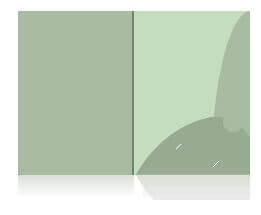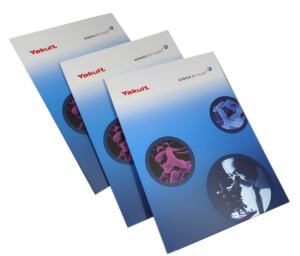If you’ve set out to print presentation folders you’re going to need to know a few basics. The following folder printing tips will have you up to speed in a flash.
We’ve only got 3 minutes, so here goes:
CMYK:
- this is the abbreviation printers use which means ‘full colour’. It’s short for Cyan, Magenta, Yellow and Black. Unless you’re printing something very basic, in a single colour (eg a white folder with your logo in blue), it’s probably more cost-effective to print in CMYK.
- If you’re including any images (photos, product shots etc), you need to print in full colour.
Outside / Inside:
- You’ll need to decide whether you want to print on the outside only, or inside too. Remember that when your folders are being made the board is flat, so if you print ‘outside only’ you can print on the pocket at the same time for free!
Folder capacity:
- This is the depth of the pocket, sometimes referred to as the gusset (I know). If you need to include a company brochure, measure the spine to see how wide the pocket needs to be on your folders. If you’re not sure – ask for some samples with various pocket depths (the usual options are 0mm, 5mm and 10mm) and try for yourself.
Business card slot:
- Do you want to include a business card when you send your folder to clients / prospects? Remember to tell your printer as they’ll need to cut slots in the pockets.
- Want to include 2 business cards side by side? No problem.
- Most important of all, remember to tell your printer whether your business cards are landscape (short and wide) or portrait (tall and thin). Your cards will look silly if you have to turn them 90 degrees to put them into your folder.
Glued pockets, or interlocking?
- You can have the pockets on your folders in one of two ways: glued – the pocket has a tab which is glued, and the folders arrived ready to be used straight out of the box, or interlocking – the folder is supplied creased but flat (unfolded), with a tab and slot mechanism for you to assemble as and when you need them.
- Remember – if you have a glued folder with a 5mm or 10mm capacity pocket, they’re going to take up a lot more space than an interlocking folder, or a folder with no capacity.
- Interlocking pockets are probably only suitable up to 5mm capacity. If you need to put lots of things (or a heavy catalogue) into your pocket – glued is probably your only option. Get some samples and see for yourself.
Lamination and Spot UV:
- Folders are usually printed on a coated board, which means they have a smooth service (as opposed to say, a letterhead, which feels a bit more textured – that’s uncoated).
- Coated board generally comes in two styles – gloss or silk. Silk has a sheen, gloss has more of a shine (but it’s not super shiny).
- To make folders more durable, you can have them laminated. Lamination generally comes in two finishes – gloss or matt.
- Gloss lamination is super shiny, and makes colours look really bright and vibrant. Matt lamination is really smooth, but can darken colours a little.
- There are other lamination options (eg soft-touch, anti-scuff etc) although they’re quite expensive. If you really need to wow someone – ask your printer for more info.
- If you choose matt lamination, you can add a contrasting glossy varnish over come elements to add impact to certain areas (eg your logo, or images). This is called spot UV varnish. It adds slightly to the cost, but it really makes you stand out from the crowd. If you’d like to see an example, click here and we’ll send you a sample in the post.

- Many printers will hold a range of stock cutters. You’ll save some money if you use an existing cutter, but for something unique you can have a cutter of your own – they’re not that expensive and you could have a pocket with a cut-out around your logo.
Presentation folder design:
- Are you a designer? If you are, and you use InDesign, these cutters will give you a head start. There’s a video there too on how to put your file together for print.
- If you’re not a designer, choose a supplier that can offer you an end-to-end service. A good folder design need only take a couple of hours and won’t break the bank.
That just about covers the basics of folder printing. If you’ve thought about these points before you request a quote you’ll save yourself a lot of time, and you’ll get a quote much more quickly.

